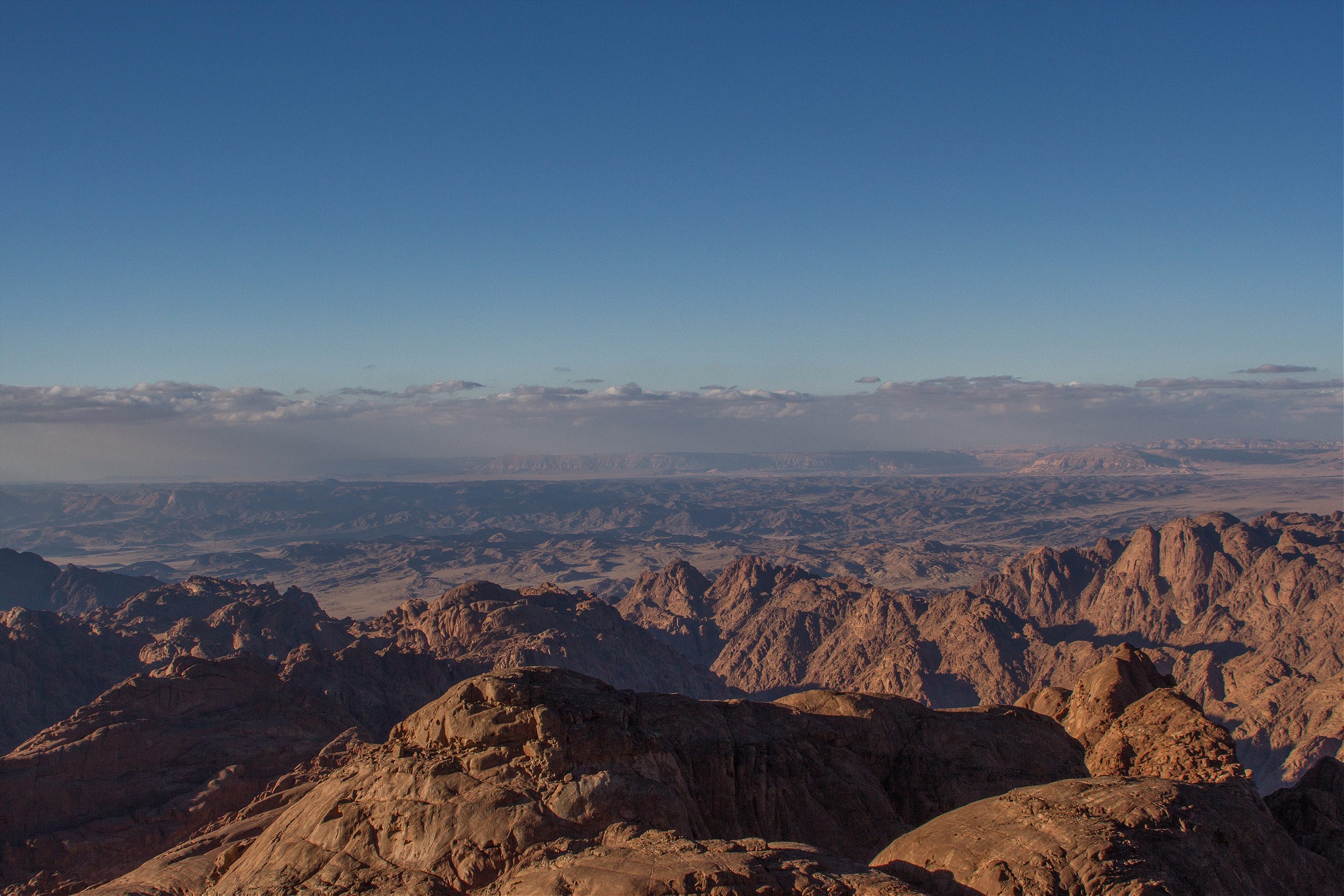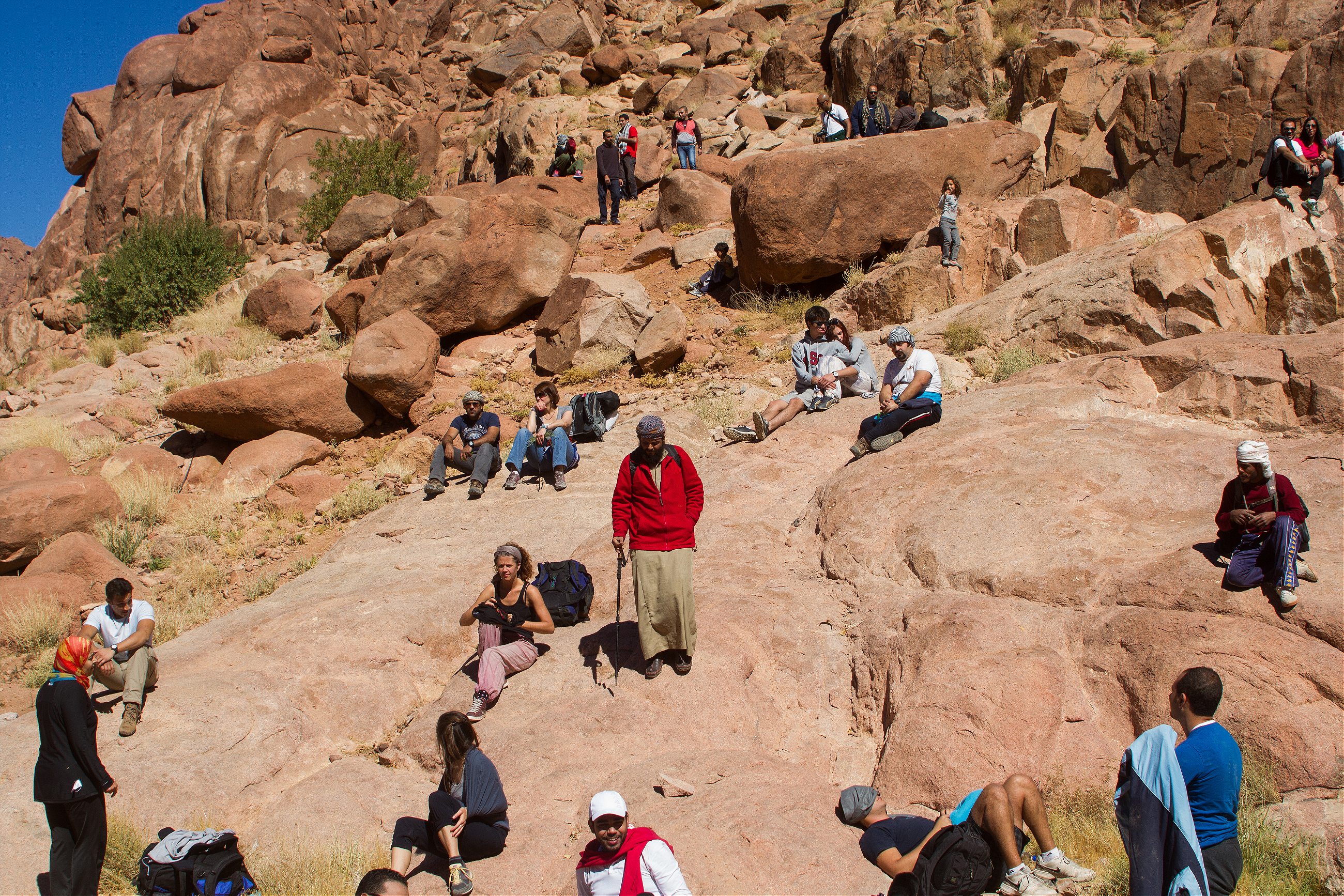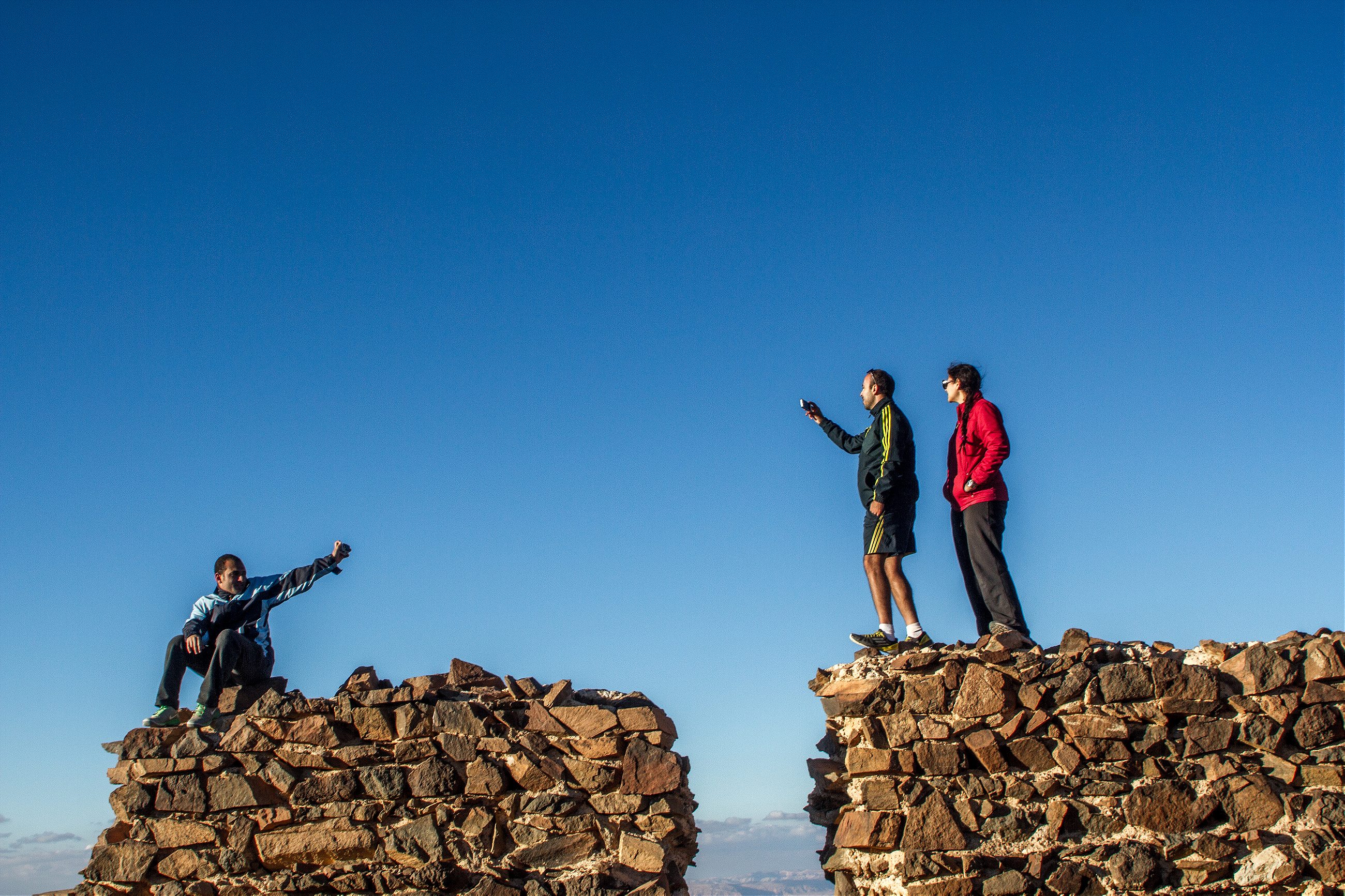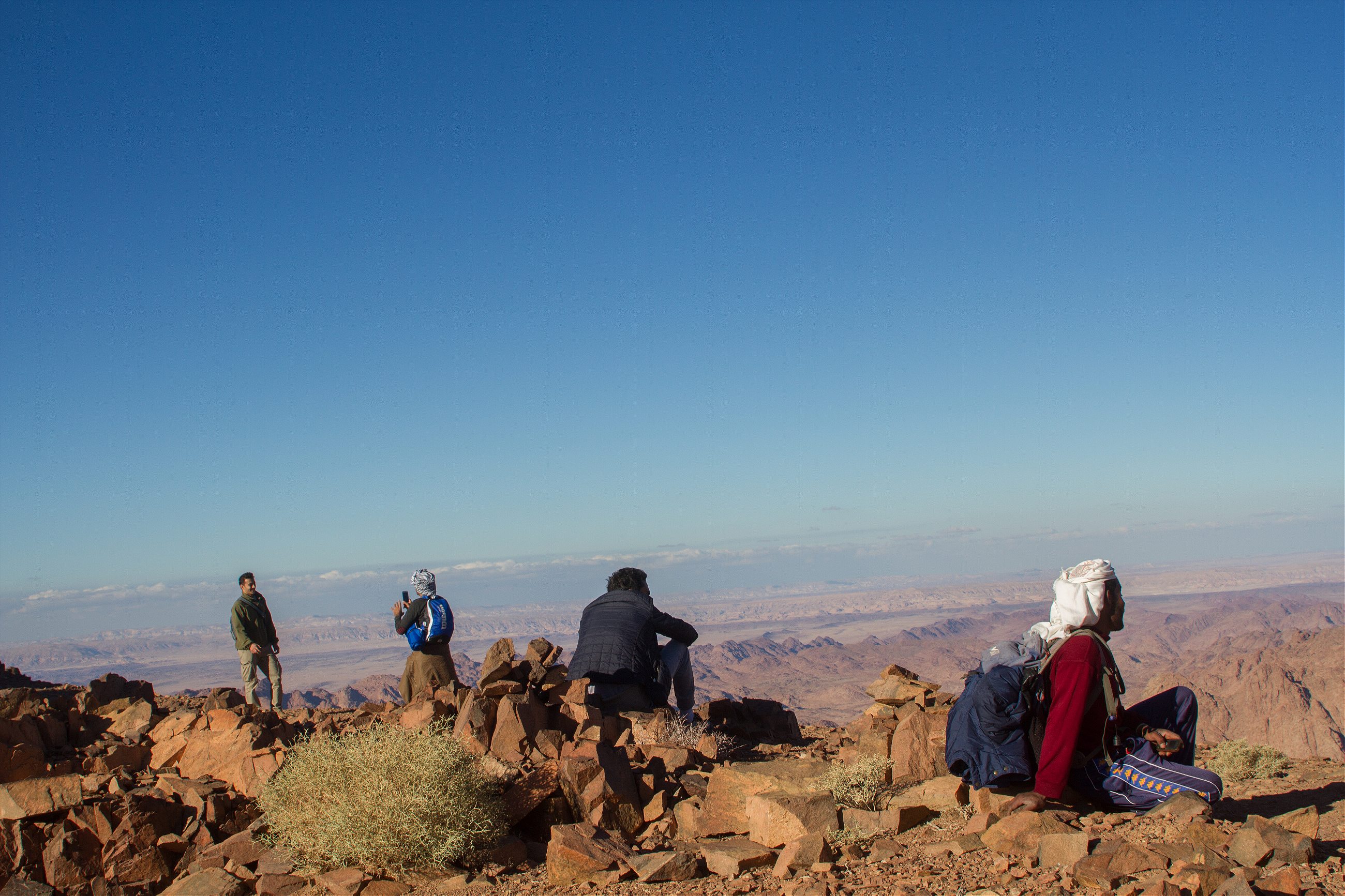After suffering two decades of sporadic violence, Egypt’s Bedouins are trying to build an ecotourism industry and break down stigmas about their homeland.
Reach the higher peaks of South Sinai and the mountains spread forth like undulating heartbeats. From up here, you can see from north to south, from desert to sea. The geography is fluid. Borders overlap and intertwine, all defined and interpreted through the visions of developers, the Egyptian military, and Bedouin tribes.
In St. Katherine, the landscape remains unchanged. Centuries old camel and goat paths are etched into mountains, which emerge stark and jagged from the desert. An Ottoman fort overlooks the city. Family gardens, passed down through generations, scatter the range. Sprinkled throughout the area are long-abandoned vegetable cellars and cave dwellings.
I’ve come to the Sinai for a locally organized trek called “Sinai is Safe.” For two days, a group of Bedouin guides directs 65 Egyptians and a few foreigners through the mountains. We sleep beneath the stars in a Bedouin garden, under the cover of olive and pomegranate trees.
South Sinai has been struck with several major terrorist attacks
The event is partly an advertisement for the stunning landscape, an attempt to show off the potential for a thriving ecotourism business. But mostly it’s a public declaration against a deep-seeded stigma against the Sinai Peninsula and its people. The hike “will make the people be more brave to come to this part of Egypt, because in the media they keep on showing that is like a war zone, while is the most peaceful place in the planet,” says Omar, from Cairo, one of the trip’s organizers who came to Sinai several years ago and has been returning ever since.

Omar’s heart is in the right place, but he’s not being entirely candid. Over the past twenty years, South Sinai has been struck with several major terrorist attacks. First was the 2004 bombing of the Taba Hilton, which killed 31 people. Then, in 2005, militant Islamists targeted Sharm El Sheikh, a coastal resort city, with three bombs, killing roughly 70 people.
The ensuing years saw several other bomb attacks, including one in Dahab, a scruffy tourist town on the coast, where 23 people were killed. During the 2011 Egyptian Revolution, bombings increased and militants began kidnapping tourists. (They were reportedly treated well.)
As the terrorist attacks drove tourists away, St. Katherine began to suffer. “Children, money, school, it’s a different life and has gotten more expensive,” says Nasser, a mountain guide in St. Katherine. “Before all people worked on the land, all the same level, no one poor, no one rich.”

The Gebeliya, the dominant Bedouin tribe in St. Katherine, have inhabited this land since the tribe first settled in the area in the 6th century. Originally from the Black Sea region, the Gebeliya were contracted by the Monastery of St. Katherine to protect the building from invading Berber tribes from Sudan and Libya. The modern Gebeliya are the descendants of this troop.
Bedouins grow up roaming these mountains, and it is this tradition and deep knowledge of the landscape that has allowed them to maintain control of the area.
“When we see anyone from outside in the mountains, we ask, ‘Why are you here? What are you doing?’” says Sheikh Ahmed of the Gebeliya. “We work to protect the tourists, because that’s our business.”
Mosallem Farraj, a mountain guide from the seaside town of Nuweiba, says, “We know who is going in the mountains, in the desert. If there is danger, we will know very fast.”

In 2010, Egypt’s tourism industry was worth $12 billion, roughly 11.3 percent of the country’s GDP. An estimated 12.5 percent of the country’s populace works in tourism. But last year, revenue dropped to $5.9 billion. Most tourism dollars are siphoned to international tourism companies and hotel chains. In Sharm El Sheik, one of the country’s only stalwart tourist destinations, resorts mostly hire transplant seasonal workers from Cairo and Alexandria. The Bedouins make money from small private tourist companies, which have suffered the most during the tourism recession.
The Bedouins work closely with the military and help guide them across the rough terrain to root out militants and smugglers. The Egyptian military has long struggled to understand the nuances of Bedouin culture in the South Sinai and elsewhere. In one case, according to Sheikh Ahmed, the army built a school for the nomadic Bedouins. When officials came to check on the school, the tribe had moved to another region, and the brand new classrooms were left empty.

For centuries St. Katherine was a primarily agricultural society. Locals grew vegetables, olives, and fruit on small plots of walled-off land deep in the mountains. From there they traveled in caravans of camels to Cairo and beyond to sell or trade their oils and fruits for meat and other supplies.
“For Bedouins, the garden is very important in the history and even now. With a garden, the Bedouin has assets—he has something on his land. Land is always worth something for us,” says Mohamed Khedr Al Jebaali, an organizer at the Community Foundation for South Sinai, a local NGO working to reestablish the local agricultural economy.
Over the years, the allure of tourist money drove young people to nearby cities and towns, leaving behind the hard and solitary traditional life in the mountains. Without anyone to rebuild washed out perimeter walls, patch up irrigation lines, and keep the trees healthy, many of the gardens fell apart.

Now, without tourists, the gardens are beginning to return. “My grandfather bought this garden a hundred years ago. After that my father worked on it as well, and when my father stopped, he left it and for 20 years it was not used,” says Hussein, who, like most Bedouins, holds several jobs and tends a garden a short distance from St. Katherine. “Before there was work with tourism. Now I got back again to work there because it’s important for the home.”
The Bedouins in the area hope to build a sort of self-sustaining hiking ecotourism economy, where visitors stay in basic, low-impact camps in the working gardens, eat locally grown organic food, and hike the trails with local guides. But there is a long way to go. The week before the hike, militants attacked an army checkpoint in the north, killing 33 police officers and soldiers. Sinai’s roads are segmented by checkpoints, and foreigners are barred from traveling on some roads, except via public transportation.
Tourists and tourism money drained out of the country
Egypt’s Revolution changed the landscape of the country in subtle ways. In the cities, temporary checkpoints and barriers sprung up, and slowly became permanent. Shoddy brick buildings began to rise in the countryside, as developers and squatters took advantage of the anarchy and carved out swaths of private and public land for themselves. Husks of ambitious tourism projects—resorts and compounds—lay baking in the sun, as tourists and tourism money drained out of the country.
In St. Katherine, the revolution in its own way paved the path for a revival of the Gardens of the High Mountains. The crumbling walls are slowly being rebuilt, piece-by-piece, and local produce is beginning to appear in community markets. Without tourism, the Bedouins were forced to return to the hard physical labor in the mountains. But by returning to the land, instead of relying on unstable work in tourism, they are securing a more sustainable, albeit less lucrative, economy and culture for future generations.
“In Sinai, a lot of prophets visit here and a lot of people come to this area,” says Faraj Mahmoud, a Gebeliya community leader in St. Katherine. “We have 48 monks who live here… They feel nearer God in this land. St. Katherine is a special place.”